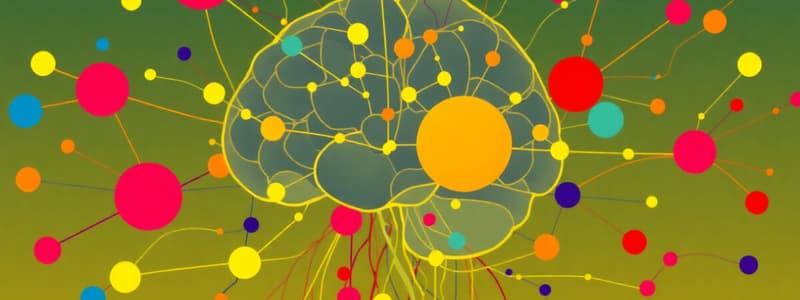Podcast
Questions and Answers
What best describes a semantic network?
What best describes a semantic network?
- A programming language for artificial intelligence.
- An organized collection of unrelated facts.
- A complex web of mathematical equations.
- A natural representation of knowledge that conveys meaning transparently. (correct)
Which statement about frames is true?
Which statement about frames is true?
- A frame is a record-like structure that can include multiple slots and facets. (correct)
- Frames only consist of a single attribute with no values.
- There can be only one facet per slot in a frame.
- Frames are exclusively used for mathematical calculations.
Which of the following is NOT a characteristic of frames?
Which of the following is NOT a characteristic of frames?
- Each frame contains only one type of slot. (correct)
- Frames can connect with each other to represent complex knowledge.
- Frames are often utilized in natural language processing.
- Slots in a frame can have multiple facets.
What is indicated by the term 'facets' in the context of frames?
What is indicated by the term 'facets' in the context of frames?
In the example frame for a book, what would be the 'slot' for the author?
In the example frame for a book, what would be the 'slot' for the author?
What type of knowledge is primarily concerned with 'knowing how' to perform tasks?
What type of knowledge is primarily concerned with 'knowing how' to perform tasks?
Which type of knowledge serves as a representation of expertise in a given field?
Which type of knowledge serves as a representation of expertise in a given field?
Which type of knowledge is described as the basic foundation necessary for problem-solving?
Which type of knowledge is described as the basic foundation necessary for problem-solving?
What role does knowledge play in the context of artificial intelligence?
What role does knowledge play in the context of artificial intelligence?
Which of the following is an example of declarative knowledge?
Which of the following is an example of declarative knowledge?
Which component of an AI system is responsible for gathering information from the environment?
Which component of an AI system is responsible for gathering information from the environment?
Meta-knowledge is best defined as?
Meta-knowledge is best defined as?
Which type of knowledge depends largely on the tasks it can be applied to?
Which type of knowledge depends largely on the tasks it can be applied to?
What is a key advantage of frame representation?
What is a key advantage of frame representation?
Which of the following correctly describes a production rule?
Which of the following correctly describes a production rule?
What happens when multiple production rules are triggered at the same time?
What happens when multiple production rules are triggered at the same time?
What is one disadvantage of frame representation?
What is one disadvantage of frame representation?
In the context of production rules, what is the working memory used for?
In the context of production rules, what is the working memory used for?
Which of the following is NOT a part of the frame representation?
Which of the following is NOT a part of the frame representation?
During the recognize-act cycle, what does the agent do?
During the recognize-act cycle, what does the agent do?
What is considered a common issue when using frame representations?
What is considered a common issue when using frame representations?
What is a primary advantage of logical representation?
What is a primary advantage of logical representation?
Which of the following best defines a semantic network?
Which of the following best defines a semantic network?
Which relation type in semantic networks is associated with inheritance?
Which relation type in semantic networks is associated with inheritance?
What is a notable disadvantage of semantic networks?
What is a notable disadvantage of semantic networks?
What might be a primary reason rational agents prefer logical representations over semantic networks?
What might be a primary reason rational agents prefer logical representations over semantic networks?
Which statement accurately describes a limitation of logical representation?
Which statement accurately describes a limitation of logical representation?
What type of abstraction do semantic networks lack that is sometimes necessary for precision?
What type of abstraction do semantic networks lack that is sometimes necessary for precision?
How do nodes and arcs function in a semantic network?
How do nodes and arcs function in a semantic network?
What is the primary purpose of the learning component in the knowledge representation cycle?
What is the primary purpose of the learning component in the knowledge representation cycle?
Which approach to knowledge representation allows for data to be organized in a hierarchy of classes?
Which approach to knowledge representation allows for data to be organized in a hierarchy of classes?
What is a key characteristic of simple relational knowledge?
What is a key characteristic of simple relational knowledge?
Which description best fits the inferential knowledge approach?
Which description best fits the inferential knowledge approach?
In the context of knowledge representation, what does the term 'instance relation' refer to?
In the context of knowledge representation, what does the term 'instance relation' refer to?
Which of the following is a drawback of the simple relational knowledge approach?
Which of the following is a drawback of the simple relational knowledge approach?
What does formal logic in the inferential knowledge approach guarantee?
What does formal logic in the inferential knowledge approach guarantee?
Which of the following best describes the role of knowledge representation in machine intelligence?
Which of the following best describes the role of knowledge representation in machine intelligence?
What is a key disadvantage of a production rule system?
What is a key disadvantage of a production rule system?
Which of the following best describes a frame in knowledge representation?
Which of the following best describes a frame in knowledge representation?
What type of link connects a class frame to its subclass in a frame network?
What type of link connects a class frame to its subclass in a frame network?
Which component of a frame can define permissible values for a slot?
Which component of a frame can define permissible values for a slot?
How do instance frames differ from class frames?
How do instance frames differ from class frames?
Which slot type would be used to store additional rules or information within a frame?
Which slot type would be used to store additional rules or information within a frame?
What do facets in a frame primarily represent?
What do facets in a frame primarily represent?
What does the term 'is_a' signify in a frame network?
What does the term 'is_a' signify in a frame network?
Flashcards
Declarative Knowledge
Declarative Knowledge
Knowing about something. It includes concepts, facts, and objects. Think of it as descriptive knowledge, expressed in statements.
Procedural Knowledge
Procedural Knowledge
Knowing how to do something. This includes rules, strategies, and procedures.
Meta-knowledge
Meta-knowledge
Knowledge about other types of knowledge. It's like meta-thinking: thinking about thinking.
Heuristic Knowledge
Heuristic Knowledge
Signup and view all the flashcards
Structural Knowledge
Structural Knowledge
Signup and view all the flashcards
Intelligence and Knowledge
Intelligence and Knowledge
Signup and view all the flashcards
AI Knowledge Cycle
AI Knowledge Cycle
Signup and view all the flashcards
Simple Relational Knowledge
Simple Relational Knowledge
Signup and view all the flashcards
Inheritable Knowledge
Inheritable Knowledge
Signup and view all the flashcards
Inferential Knowledge
Inferential Knowledge
Signup and view all the flashcards
Learning
Learning
Signup and view all the flashcards
Perception
Perception
Signup and view all the flashcards
Knowledge Representation
Knowledge Representation
Signup and view all the flashcards
Reasoning
Reasoning
Signup and view all the flashcards
Planning and Execution
Planning and Execution
Signup and view all the flashcards
Semantic Networks
Semantic Networks
Signup and view all the flashcards
Frames
Frames
Signup and view all the flashcards
Facets in Frames
Facets in Frames
Signup and view all the flashcards
Frames and Stereotypes
Frames and Stereotypes
Signup and view all the flashcards
Frames and Interconnectedness
Frames and Interconnectedness
Signup and view all the flashcards
Logical Representation
Logical Representation
Signup and view all the flashcards
Propositional Logic
Propositional Logic
Signup and view all the flashcards
Predicate Logic
Predicate Logic
Signup and view all the flashcards
IS-A relation (Inheritance)
IS-A relation (Inheritance)
Signup and view all the flashcards
Kind-of-relation
Kind-of-relation
Signup and view all the flashcards
Computational Time
Computational Time
Signup and view all the flashcards
Link Name Ambiguity
Link Name Ambiguity
Signup and view all the flashcards
Frame Representation
Frame Representation
Signup and view all the flashcards
Production Rules
Production Rules
Signup and view all the flashcards
Working Memory
Working Memory
Signup and view all the flashcards
Recognize-Act Cycle
Recognize-Act Cycle
Signup and view all the flashcards
Conflict Set
Conflict Set
Signup and view all the flashcards
Conflict Resolution
Conflict Resolution
Signup and view all the flashcards
Inference Mechanism in Frame Representation
Inference Mechanism in Frame Representation
Signup and view all the flashcards
Inference Mechanism Integration with Frame Representation
Inference Mechanism Integration with Frame Representation
Signup and view all the flashcards
Frames in AI
Frames in AI
Signup and view all the flashcards
Slots in Frames
Slots in Frames
Signup and view all the flashcards
Frame Network
Frame Network
Signup and view all the flashcards
Class Frame
Class Frame
Signup and view all the flashcards
Instance Frame
Instance Frame
Signup and view all the flashcards
Frame Hierarchies
Frame Hierarchies
Signup and view all the flashcards
Links in Frame Networks
Links in Frame Networks
Signup and view all the flashcards
Study Notes
Knowledge Representation
- Knowledge representation and reasoning (KR, KRR) is part of Artificial Intelligence (AI)
- It focuses on how AI agents think and how their thinking contributes to intelligent behavior
- KR allows computers to understand and use knowledge to solve complex problems (e.g., medical diagnoses, natural language communication)
- It describes how knowledge can be represented in AI, not just storing data, but also enabling learning from that knowledge and experience to achieve intelligent behavior like humans
Types of Knowledge
- Object: Facts about objects in a domain (e.g., guitars have strings)
- Events: Actions that occur (e.g., actions in a game)
- Performance: Describes how to do things (e.g., procedures)
- Meta-knowledge: Knowledge about knowledge (e.g., knowing what you know)
- Facts: Truths about the real world
- Knowledge-Base (KB): Main component of knowledge-based AI agents, structured as a set of sentences
Types of Knowledge in AI
- Declarative knowledge: Knowing what something is (facts, concepts, objects). Expressed in declarative sentences; simpler than procedural knowledge.
- Procedural knowledge: Knowing how to do something (rules, strategies, procedures). Imperative knowledge, directly applicable to tasks.
- Meta-knowledge: Knowledge about other types of knowledge
- Heuristic knowledge: Expert knowledge, often rules of thumb based on experience, potentially not guaranteed to work
Structural Knowledge
- Basic knowledge for problem-solving
- Describes relationships between concepts (e.g., "kind of," "part of," grouping)
- Details the connection between concepts or objects
Knowledge and Intelligence
- Knowledge of the real world is vital for AI and creating artificial intelligence
- AI agents can only accurately act on input if they have knowledge about it
- Knowledge enables intelligent behavior in AI agents
AI Knowledge Cycle
- AI systems use several components to display intelligent behavior:
- Perception (acquiring environmental information)
- Learning (analyzing data from perception)
- Knowledge Representation and Reasoning (representing knowledge, drawing conclusions)
- Planning (developing strategies)
- Execution (carrying out plans)
- These components interact to enable intelligent behavior
Knowledge Representation Approaches
- Simple Relational Knowledge: Stores facts in columns (e.g., database format). Limited inference capabilities.
- Inheritable Knowledge: Represents data in a hierarchy of classes; objects inherit properties from parent classes
- Inferential Knowledge: Represents knowledge using formal logic (e.g., propositional logic, predicate logic). Allows for derivation of new facts.
- Procedural Knowledge: Uses programs that describe how to do something. If-Then rules are often used
- Example of simple relational knowledge: A table with columns for 'Player', 'Weight', and 'Age'.
Requirements for Knowledge Representation Systems
- Representational Accuracy: System must accurately represent all required knowledge.
- Inferential Adequacy: System must effectively manipulate existing structures to create new knowledge matching existing structures
- Inferential Efficiency: System must direct the inferential mechanism to the most productive solutions.
- Acquistional Efficiency: System must easily acquire new knowledge
Knowledge Representation using Semantic Networks
- Four main approaches:
- Logical representation
- Semantic network representation
- Frame representation
- Production rules
Logical Representation
- Uses a formal language with concrete rules and propositions
- Avoids ambiguity
- Allows for clear communication rules
- Includes a precise syntax and semantics
- Categorized into:
- Propositional logic
- Predicate logic
Semantic Network Representation
- Alternative to predicate logic for representing knowledge graphically
- Nodes represent objects, arcs represent relationships between objects
- Simple to understand and expand
- Consists of:
- Is-A Relation (Inheritance)
- Kind-of Relation
Frame Representation
- Record-like structure with attributes and values
- Organizes knowledge into slots, facets
- Divided into subsets
- Uses slots and slot values for specifying features
- Example: A frame for a "Book" object might include slots like "Title," "Author," and "Pages."
Production Rules
- Consists of (condition, action) pairs ("If condition then action")
- Three parts include:
- Set of production rules
- Working Memory
- Recognize-Act Cycle
- Example IF (at bus stop AND bus arrives) THEN action (get into the bus)
Disadvantages of Production Rules
- Doesn't have learning capabilities
- Potential for many active rules during execution, leading to inefficiency
Studying That Suits You
Use AI to generate personalized quizzes and flashcards to suit your learning preferences.
Related Documents
Description
Test your understanding of various types of knowledge related to artificial intelligence, including semantic networks, frames, and knowledge representation. This quiz covers key concepts that are essential for grasping how AI systems function and learn. Discover the differences between declarative, procedural, and meta-knowledge.




